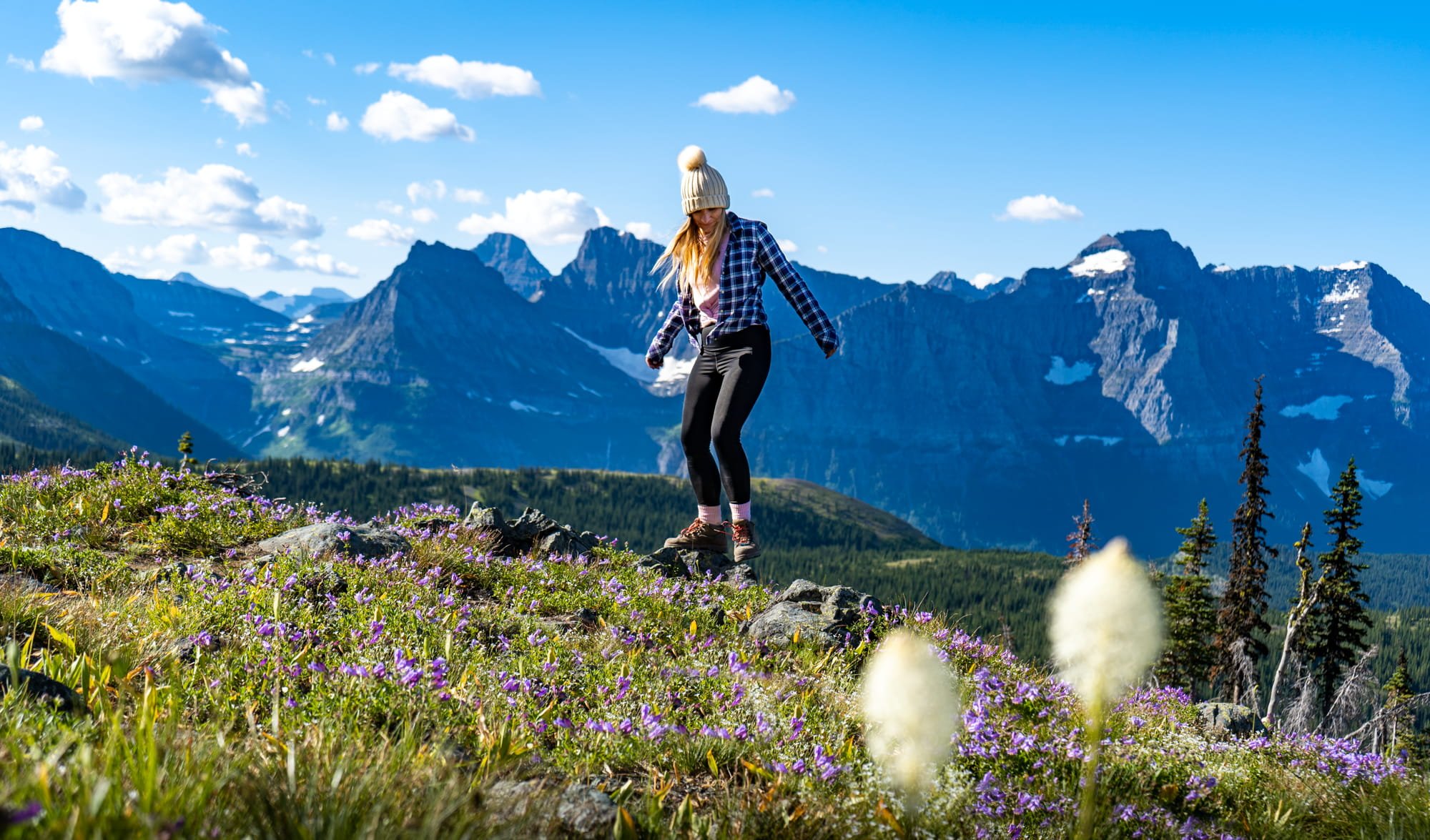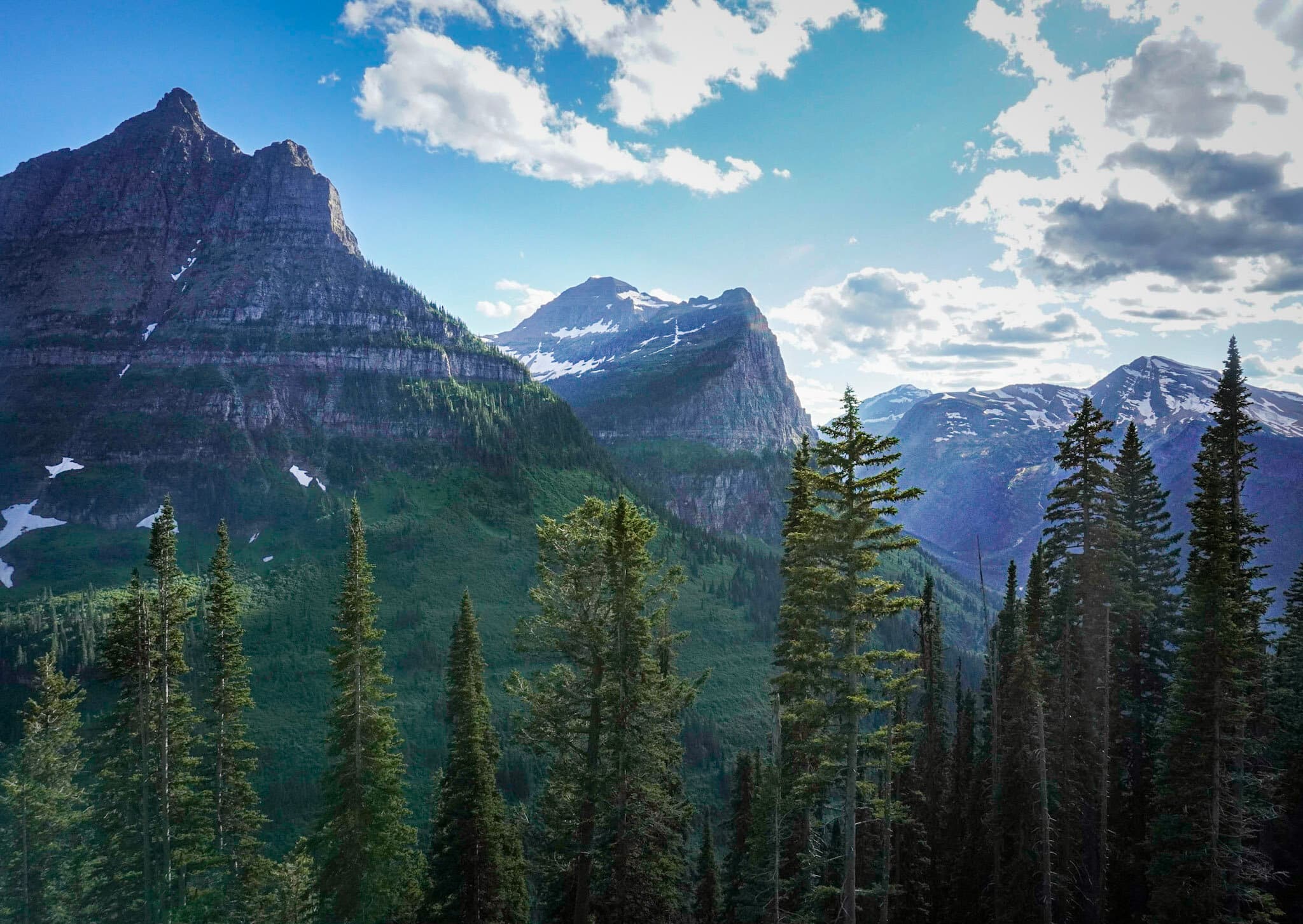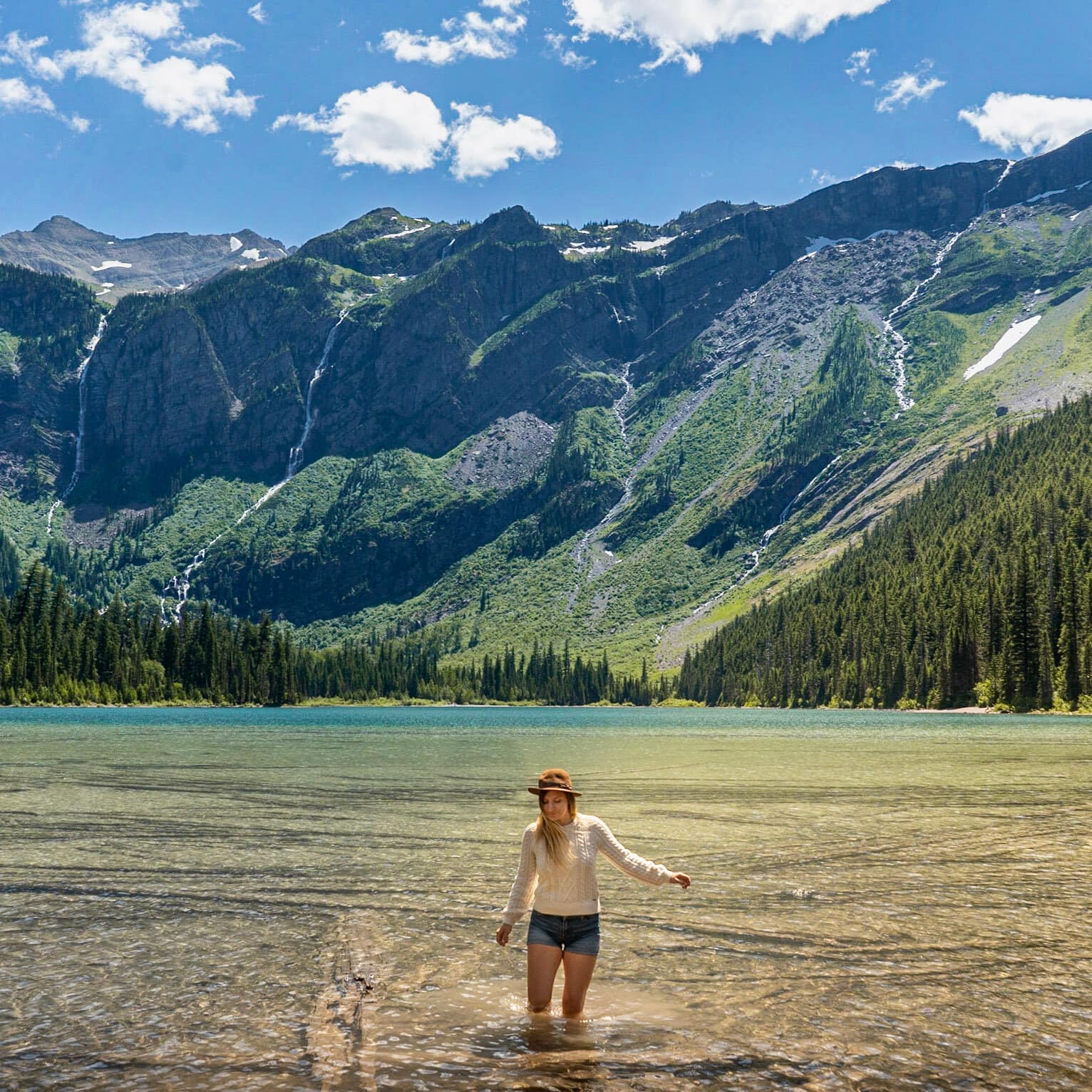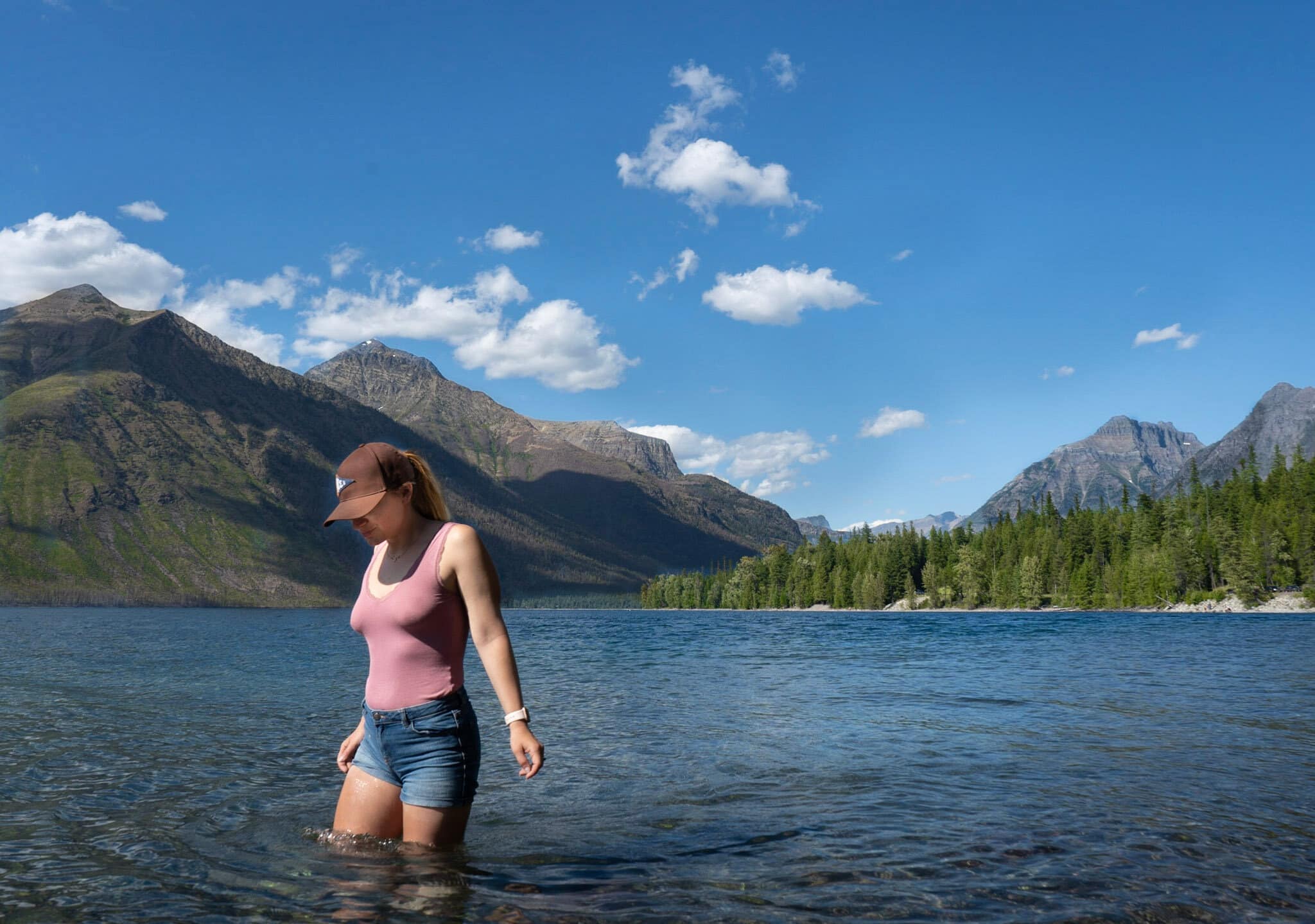Planning a trip to the gorgeous Glacier National Park? Then you’re surely planning to cruise along the Going-to-the-Sun Road, an iconic 50-mile road, carved into the park’s mountainsides that takes drivers up and through the Rockies, with absolutely spectacular views around every bend. This epic scenic drive is one of the most popular things to do in Glacier, so it’s definitely worth planning ahead so that you can make the most of your time on this bucketlist-worthy road.
Here are 10 tips to ensure you have the best time driving on the Going-to-the-Sun Road in Glacier National Park.
This post may contain affiliate links. If you make a purchase through them, we may receive a small commission, for which we are extremely grateful, at no extra cost to you.

What is the Going-to-the-Sun-Road?
The Going-to-the-Sun Road is famous for a few reasons. For example, it is often lauded as both a historical and engineering landmark and for the fact that it uniquely traverses the Continental Divide. However, it’s mostly known for its jaw-dropping views of the Rocky Mountains and the surrounding alpine lakes, fields of wildflowers, and pine tree forests.

The road was built between 1921 and 1932, as one of the first attractions in the U.S. National Park System to accommodate automobile-borne tourists.
With 12 miles of the road literally carved into the side of a mountain and thoughtfully designed to seamlessly integrate into Glacier’s gorgeous landscape, it has received countless accolades and was the first road to be designated as each a National Historic Place, National Historic Landmark, and Historic Civil Engineering Landmark.

When I was planning my trip to Glacier, I was a bit puzzled by the sheer volume of blog posts that sung this road’s praises- while I like a lovely drive through the mountains as much as the next person, I didn’t really quite get all the fuss.
Well, friends, the fuss is 100% worth it- the views are absolutely spectacular, with the drive taking you across sparkling lakefronts, up and over the grandest mountains I’ve ever seen, and through glacial meadows. It’s so beautiful, in fact, it’s been included in multiple movies, like The Shining and Forest Gump.

Why is it called the Going-to-the-Sun Road?
Not-so-fun backstory time: Glacier, like most other U.S. National Parks, was originally home to Native people, specifically the Blackfoot nation.
The Blackfoot tribe’s land, at one time, spanned more than 28 million acres, but when the United States government became interested in mining the land that is now Glacier National Park in 1895, the Blackfoot nation and the U.S. government struck a deal for the land, which was characterized by the tribe as a lease and permitted its people to hunt and gather on the land.

The U.S. government did not hold up its end of the bargain- the agreement was not treated as a lease, with Glacier being established as a national park in 1910 and tribal members being arrested for hunting in the park as early as 1912. Since the U.S. government took possession of the land, many important names and cultural landmarks from the Blackfeet tribe have been erased by the masses, and now, the Blackfeet reservation, which remains on the east side of the park, has shrunk to only 1.5 million acres.
I say all this to provide a perspective that, while Glacier is a beautiful and beloved national park, its history and its relationship with Native people is problematic, to say the least.
With that context in mind, the National Park Service named the road in 1933 after the Going-to-the-Sun Mountain, which dominates the eastbound view of the road beyond Logan’s Pass. Apparently, a white settler named James Schulz concocted a story, allegedly told by the Blackfoot people, that a deity named Napi (or Sour Spirit) came down from the sun to teach the Blackfoot tribe how to hunt. While he was returning to the sun, Napi imprinted his face at the top of the mountain to inspire the Blackfeet people.

Some believe that Schulz may have been confused or blending Blackfeet legend- a separate mountain, Matahpi Peak (or “Face Mountain” in Blackfoot) gets its name from a snowfield near its peak that resembles a chief’s face.
I’d encourage you to learn more about the Blackfeet people and their culture, which are very much still alive and well, when you’re visiting Glacier- for example, Sun Tours is a company that provides tours of Glacier, which are inclusive of Blackfeet history and culture and provided by tribal members. It’s a great way to support a local business and hear an important perspective of the land.
How do I get to Glacier National Park to visit the Going-to-the-Sun Road?
There are no major airports close to Glacier National Park, which is located in the Northwestern part of the Montana state.

While there is the tiny Glacier Park International Airport 30 miles away in Kalispell, Montana, you’ll probably be able to get to Glacier much cheaper by either flying into Spokane, Washington (about a 4 hour and 45 minute drive from the west entrance of the park) or Bozeman, Montana (about a 5 hour drive from the east entrance of the park) and then renting a car to get to and around the park.
Alternatively, you can go the route that my husband, Justin, and I did- road trip! We drove from our home in Seattle, through the hot springs of Idaho, through Grand Teton and Yellowstone, and finally ended in Glacier. This area of the United States was seriously built for road trips- there’s so much epic scenery and endless outdoor adventures to be had, so if you can swing it from your home state, I’d highly recommend!

Vehicle Reservations for the Going-to-the-Sun Road
From June 13 through September 28, 2025, you’ll need a vehicle reservation to get into the Going-to-the-Sun Road from the west side and North Fork between 7 AM and 3 PM. You can learn more about these reservations and make one for yourself at the National Park Service’s website.
When we visited the park a couple of summers ago, we saw LOTS of people get turned away at the gate for not having reservations, regardless of whether the drivers cried hysterically and told stories about how they’d just driven for over 20 hours to reach the park or screamed obscenities at the rangers (yup, I saw both of these actually occur!).

If you’re unable to get a vehicle reservation during your visit, you can alternatively enter the park either before 7 AM or after 3 PM. This is exactly how Justin and I drove on the Going-to-the-Sun Road and never had any issues!
Tips for Driving the Going-to-the-Sun Road
Without further ado, here are some tips on how to make the most of your Going-to-the-Sun Road excursion:
1. Know when to visit the Going-to-the-Sun Road.
While portions of the road stay open year round, the majority of it is closed for most of the year, due to the heavy Montana snowfall and the long winters. Historically, the road has opened around late June or early July and closed late September to early October.

During my first visit to the park in 2020, it was the second latest opening in the history of the park, opening on July 13th (I was biting my fingernails- this was just 2 days before we arrived!), due to resource shortages related to COVID. So, to be on the safe side, I’d recommend planning your visit in mid to late July through early September.
2. Make sure your car is allowed to drive on the road!
Given the amount of sharp turns and overhangs, your car (or your vehicle combination if you have an RV) must be less than 21 feet long, 8 feet wide (including mirrors), and 10 feet high. Therefore, a lot of campervans and other RVers that are too long will need to figure out a different solution to drive along the road.
Thankfully, for those of us loving that RV life, there’s plenty of spots to drop an oversized vehicle at either the entrance of the park, including the Apgar or Saint Mary Visitor Centers. From there, you can take the park’s free shuttle, which runs the entire length of the Going-to-the-Sun Road.

3. Be like a Girl Scout and be prepared.
There are no gas stations inside of Glacier National Park and cell phone coverage is spotty, at best. So make sure your gas tank is full, you’re good on snacks, and you’ve downloaded offline maps for the park and the surrounding area on Google Maps and for any trails that you want to hike on AllTrails.
4. Budget enough time.
You’ll have to drive slowly on the road- 45 mph through lower elevations and 25 mph in the alpine sections. Plan for plenty of time to pull over, gawk at the scenery, and take photos.

If you just plan on driving the whole things without stopping at overlooks or trails, budget for at least two hours. However, if you plan on stopping along the way to stretch your legs or better yet, hike (more on that below!), this could easily turn into an all day activity.
5. Drive from the west to the east.
The road stretches for 50 miles from the west side of the park, at Lake McDonald, to the east side, at St. Mary. Therefore, you can generally drive the road either way- west to east or east to west.
While either direction will provide fantastic views, I’d recommend driving the road from west to east, as you’ll be on the outer edge of the road driving through the portions that are carved into the side of the mountains, making the views even more spectacular and with easier access to pull-offs.

If you’re in Glacier for a short period of time, I’d also use this tip to pick your base of where to stay when visiting the park. If you’re driving from west to east, it makes the most sense to stay near the west entrance in the quaint town of Whitefish or the funky Columbia Falls, given that St. Mary and other towns around the east entrance can be a two hour plus drive from the west entrance.
Some places I’d recommend staying at near the west entrance are Hampton Inn and Suites Whitefish, Grouse Mountain Lodge, and The Farmhouse Inn in Whitefish or, alternatively, Meadow Lake View Bed and Breakfast, North Forty Resort, and Meadow Lake Resorts in Columbia Falls.

If you’re a nervous nelly driver and would prefer, perhaps, a less dare-devil-y route (i.e., driving on the side closest to the actual mountainside), it might make sense to go from the east to the west. If you want to go this route, I’d recommend checking out accommodations in East Glacier Park Village (which are notably WAY more limited than the west side), such as Glacier Park Lodge.
Fair warning- Glacier is extremely popular (with good reason), which means that accommodations are EXPENSIVE and, in the summer months, can book up well in advance. As such, I’d highly recommend making reservations several months before your trip!
6. Start early!
Not only is the Going-to-the-Sun Road itself a huge attraction, but many of the park’s most popular hikes have trailheads along the route. Given that the road is pretty packed between 9 am and 5 pm during the busy summer months, I’d strongly recommend getting a head start and hitting it early.
Another huge benefit of the early morning wake-up call is getting to see the spectacular alpine glow at sunrise in the park. This also just so happens to be one of the best times to spot wildlife, like bear, moose and mountain goats.
The park is usually pretty chilly in the morning, though, so I’d recommend packing layers. For example, we both swear by our cozy fleece pullovers.

7. Pack some binoculars.
Spotting wildlife in Glacier isn’t quite as easy as some other national parks, like Yellowstone. So if you are committed to finding some new furry friends, I’d recommend packing a pair of binoculars to help you spot them. Try to plan your visit either first thing in the morning or at dusk, as animals are most active at these times to avoid the heat of mid-day.
Finally, most rangers will be able to provide you tips on up-to-date wildlife spottings and where you’ll have the best chance of viewing the animals from a safe distance. While most wildlife at Glacier tend to be a bit more on the elusive side, a reminder in case they’re feeling particularly friendly during your visit- you should always view bears from at least 100 yards away and all other animals from at least 25 yards away.

8. Plan your route.
As mentioned above, while driving along the road is an activity in and of itself, there are so many stops along the way for you to get out of your car, hike around, and explore. Some favorites, heading west to east, include:
Lake McDonald
If you’re starting the drive from the west entrance, this will be the first significant landmark you’ll hit in the park. This fjord-like lake is the largest body of water in the park, stretching 10 miles long, and is known for the rainbow-colored rocks lining its floor. There’s plenty of places here where you can jump in the water, paddle around, or simply take in the beautiful scenery.

If you’re planning on stopping at the lake for a while, there’s a handful of cute little beaches, like Apgar Beach, for you to chill ‘til your heart’s content.
If this sounds up your alley, I’d suggest packing a swimsuit (here’s an option for men), a travel towel, and a beach blanket. My husband, Justin, and I thought Lake McDonald was so pretty, we stopped here during our second day in the park to have a relaxing lunch while drinking in the views. Highly recommend!

Avalanche Lake
For one of Glacier’s best bang-for-your-buck hikes, stop at this four-mile out-and-back trail, with moderate elevation gain, multiple stunning waterfalls and a heart-droppingly beautiful alpine lake.

This is a super popular trail, so if you plan on hiking here, I’d encourage you to start early. Justin and I arrived here by 9 AM and the closest parking spot we could find was about a mile away. It was worth it, though- in fact, we loved this hike so much, we have a whole post all about hiking to Avalanche Lake.
The Loop
The Loop is a hairpin turn where the road starts slowly climbing up through the mountains (and is one of the main reasons why vehicles longer than 21” would be dangerous to drive on the road).

You can either make a quick stop here to take in the beautiful mountain views or alternatively, take several longer hikes (which were my personal favorites in the park!), like the Granite Park Trail, to a rustic chalet perched on top of a mountain with 360 degree views of the Rockies or adding on the offshoot to the Grinnell Glacier Overlook once you’re at the chalet, for breathtaking views of a glacier-fed electric blue lake.
Weeping Wall
There’s a craggy 100-foot rock face alongside the road where snowmelt run-off rushes down the cliffside and creates a chilly torrent that splashes into the roadway.
You can either jump out of your car to run through its waters to cool off after a long hike or drive your car right through it. But unless you want a very wet (and very cold) car- be sure to close that sunroof!

Logan Pass Visitors Center
Both the highest point along the Going-to-the-Sun-Road, at 6,647 feet in elevation and the crossing point of the Continental Divide, the Logan Pass Visitor Center is a great pitstop for a bathroom break and fantastic views (and one of the best spots in the park to spot mountain goats!).

It also happens the be the starting point of two of the most popular hikes in the park, the 11.8-mile one-way Highline Trail, which is frequently called the most beautiful trail in the United States, and Hidden Lake Lookout, a 2.9 mile out-and-back trail with excellent wildflower- and wildlife-viewing opportunities.
Sun Point Nature Trail
This is an easy 1.7 mile hike to an enormous rock that provides magnificent views of St. Mary Lake and the surrounding mountains.

What to Know About Hiking in Glacier National Park
If you are planning to make stops to hike some trails along the road (which you absolutely should!), here are some additional tips to consider:
Glacier National Park is bear country.
Glacier is home to both grizzly and black bears. Both kinds of bears will generally try to move away from a human if they hear, see, or smell you approaching, but certain factors, such as the noise from a stream or the wind, can make it harder for them to know you’re hiking near them.
Bears are generally not aggressive, but may act aggressively if their young is near or if you have startled them. Because of this risk, you should always have bear spray (which acts like pepper spray to deter a bear without causing permanent harm) on you any time you go hiking in bear country.

Although we thankfully have never had to use it, we have this one. Note that you cannot fly with bear spray, so if you didn’t happen to road trip to Glacier, you can rent some for affordable rates at Glacier Outfitters, right at the southern tip of Lake McDonald.
Have a Plan B.
Related to the above point, various trails are frequently closed, on a day-to-day basis, due to high bear activity. Be flexible with your plans and have some back-ups in mind if something doesn’t pan out.

Come prepared.
Since it rarely gets super hot in Glacier, it can be easy to forget to have sun protection and stay hydrated. So if you’re hiking all day in Glacier’s mountains in the midst of the summer sun, be sure to pack your sunscreen and a Nalgene bottle full of water.
9. Drive safely.
The Going-to-the-Sun Road is truly breathtaking and it’s going to be hard to keep your eyes on the road- but please do! If the driver wants to take a longer look at any of the spectacular scenery, by all means, they most certainly should- please just pull over!

Between the roads being busy, hugging literal mountain sides, and tourists and animals running every which way, it would be extremely easy to get in an accident. Drive slowly and carefully- this is definitely an activity to be enjoyed at a leisurely pace!
10. Pack your lunch.
There’re only a handful of places to grab breakfast or lunch along the road, like Two Dog Flats Grill in the Rising Sun area towards the east of the Going-to-the-Sun Road or Jammer Joe’s Grill in the Lake McDonald Lodge. To be honest, most of the available options are pretty pricey for what you get and can be packed during the busy summer months.
If you’re roadtripping to Glacier like we did, I’d highly recommend bringing along a cooler (we picked up one very similar to this for our road trips and have been using it ever since ALL the time!) and packing some sandwiches or wraps to eat on the road instead.

One of my favorite memories during my time in Glacier was drinking a huckleberry beer (did you know that Montana LOVES all things huckleberry, which are endemic to Montana?) with Justin after one of our long hikes, sitting along an overlook along the Going-to-the-Sun Road and enjoying the epic views. By bringing along your own food, you’ll not only be saving money, but you’ll also get to enjoy your meal with world class views!
I hope all of my Going-to-the-Sun Road tips help you have a spectacular time in Glacier. What are you most looking forward to seeing in the park? Any suggestions of your own? Let me know in the comments below!


Thank you for reading our post! Check out our latest stories here and follow us on Instagram (@UprootedTraveler), YouTube, or on Facebook to see what we’re up to next!



Hello, I believe reservations are not required after 3 pm not 5 pm.
Thanks for reading and for flagging! The National Park Service must’ve updated the time period where you weren’t required to have a reservation (which is awesome for those who can’t snag one; at least they can enjoy the Going-to-the-Sun Road in the afternoon!). I’ve updated the article accordingly!
Hi, really appreciated your writeup on Going to the Sun Road, lots of good tips (also enjoyed your video on selling your RV!). Thanks for a great blog, and best of luck on your continuing adventures!
Great information. If I have a hotel for two nights in Coram, MT and drive Going To The Sun from west to east; Maybe a silly question: do I take Going To The Sun Road to get back to Coram? Or; is there some other route back to Coram? Thanks.
Not a silly question at all- most people drive the Going-to-the-Sun Road roundtrip. The views actually do look a bit different, depending on which way you’re driving- and how often do you get to be on a road that’s so fantastically beautiful? Alternatively, you could drive from St. Mary’s, south along US-89 S and then turn east on U.S. Route 2 back to Coram. This route is about ten minutes shorter than the Going-to-the-Sun Road, with no stops, and will almost definitely have less traffic.
Thanks for reading and happy travels!
great article— Im in my 60s and been there and done going to the sun road. i live in midwest and wanna go back. One thing Id like to add to the drive safely idea is that there really were no guardrails on much of the road when i was there. Just little blocks kind of speed bump height. Since a person is looking around at all the fabulous scenery it would be easy to go off the edge and alot of places that is off the cliff. Way down There— I dont know that this has ever happened but Im surprised it doesnt now and then- like people fall into the grand canyon once in awhile. It was very hard to keep my eyes on the road. Just an Extra safety thought. Thanks
You’re absolutely right; such a good point! I, too, am surprised that there aren’t a bunch of drivers accidentally falling off the cliff, given how stunning it is.
Thanks for reading!
Jess
I’m headed out from Oregon to Glacier in a few days, and found this very informative–thanks!
Fingers crossed the weather cooperated with you- fall in Glacier is supposed to be STUNNING!
Happy travels!
Jess
Thanks for posting this; very informative for our upcoming trip. Wondering what your thoughts are on driving through the road during the first week of October. My wife and I are in our early 70s so we will probably just observe from the turnouts and do a minimum of hiking. Does the snow start that early?
Thanks!
Hi Bill!
The first week of October is probably fine. Per the NPS, the road is usually open through the third Monday in October, although it can close earlier than that, due to snow. For reference, you can see the dates that the road closes in past years here- https://www.nps.gov/glac/learn/news/logan-pass-opening-and-closing-dates.htm
Thanks so much for reading and hope you have an AMAZING time in Glacier!
Jess